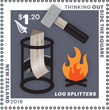When it comes to ingenuity and thinking outside the square, Kiwis win hands down. In fact, we’re world-famous for it! Backyard inventors, dreaming up widgets and gadgets, and all manner of things made from ‘number 8 wire’. Stuff that people didn’t know they needed until they saw or used it. That’s what sets us apart from the rest of the world. Here are just a few of the cool creations New Zealanders have come up with.
Covers & Miniature Sheet.
First Day Cover 1 - 5 September 2018.
First Day Cover 2 - 5 September 2018.
Miniature Sheet featuring all 12 stamps.
The Twelve Stamps.
These 12 images will be replaced when bigger and better ones become available.
$1.20 - Log Splitters.
Originally designed by 13-year-old Ayla Hutchinson for a 2012 school science-fair project, the Kindling Cracker is used to safely split wood, without losing a finger.
$1.20 LifePod Incubators.
The Mondiale ‘LifePod’ incubator was designed by inventor and scientist Sir Ray Avery for developing countries where millions of babies die each year due to lack of neonatal care. One incubator can save at least 500 lives by providing newborns with a safe, sterile, temperate environment.
$1.20 - Instant Coffee.
Invercargill merchant David Strang became the first person to create and sell commercial instant coffee when he patented his ‘Dry Hot-Air’ process in 1890.
$1.20 - The Jogging Movement.
Kiwi runner and athletics coach Arthur Lydiard (1917-2004) popularised jogging as a way to get fit by building stamina bit by bit.
$1.20 - Self-resetting Traps.
Goodnature co-founders and industrial-design graduates Stu Barr, Robbie van Dam and Craig Bond's re-setting traps get rid of rats, stoats, possums, mice, and other pests who prey on native wildlife.
$1.20 - Automatic Chicken Feeders.
Frustrated with pests eating his chicken feed, retired dairy farmer Bill Kirkham designed Grandpas Feeders to quite simply open and close when chooks step on and off the clever stainless-steel contraptions.
$1.20 - Retractable Boat Wheels.
Primarily, this is a boat you can easily launch and retrieve. Auckland electrical engineer Maurice Bryham originally designed the prototype for Sealegs Amphibious Craft with wood and Lego.
$1.20 - Ref's Whistle.
In 1884, 24-year-old Cantabrian referee William Harrington Atack was the first to realise he could save his voice by putting his dog whistle to good use on the rugby field.
$1.20 - Land Yachting.
In 1999, New Zealand hang-gliding and land-sailing enthusiast Paul Beckett tinkered in his Papamoa garage until he had a prototype for the Blokart - a fast wind-powered land yacht that kicked off a new international competitive sport.
$1.20 - Robust Brollies.
Designed to withstand winds of up to 117kmph, Greig Brebner's high-tension canopy Blunt umbrellas are named for their rounded, injury averting edges.
$1.20 - Kid-proof Caps.
After moving to New Zealand in the 1960s, Italian expat Claudio Petronelli designed a palm-and-turn prototype cap in metal and patented a plastic design in 1969 that is still used today.
$1.20 - 3-stage Bikes.
Rich Latham built the first prototype of ’the world’s first recycled children’s bike’ in his bathroom. Designed to save on waste and cost, Wishbone Bikes transform from trike to little bike, to big bike.
Technical Information.
Date of issue: 5 September 2018.
Number of stamps: 12 gummed stamps.
Denominations: 12 x $1.20.
Stamps, miniature sheet and first day covers designed by: EightyOne, Wellington, New Zealand.
Printer and process: Southern Colour Print Ltd by offset lithography.
Number of colours: Four process colours.
Stamp size and format: 37.5mm x 36.95mm.
Paper Type: Tullis Russell 104gsm red phosphor gummed stamp paper.
Number of stamps per sheet: 12.
Perforation gauge: 14.4 x 14.615.
Period of sale: Stamps will remain on sale until 4 September 2020.
First Day Covers will remain on sale until 31 October 2018.
Some of the images in this post were used with permission from the illustrated catalogue of StampsNZ
Information & images for this post came from.
















Comments
Post a Comment
We appreciate your engagement with our content. To ensure a respectful and constructive community, please take note of the following:
- No Spam, Please: We do not tolerate spammy or promotional comments. Any such comments will be promptly removed.
- Moderation in Place: All comments are moderated to maintain a positive and inclusive environment. Please be patient, as it may take a little time for your comment to appear.
- Sign In with Google: To comment, please sign in using your Google account. This helps us maintain the integrity of our community and allows for better interaction.